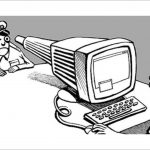Nature is the powerhouse and it has a very crucial balance, a complex food web and a hierarchy of energy levels. Every element, biotic as well as abiotic, are interdependent and has a defined purpose to serve. All the environmental threats that our planet is marred with can be routed to an inbalance of this flamboyant force and this complex interaction.
We humans, homo sapiens, are indisputably at the top of the food chain. But does that mean we are blessed to eat every animal enslaved in our food web just because they can’t put up a good fight? Or should we go by the logic of the vegetarian’s, that every animal has a natural wish to live? Food habits are a personal choice, and anyone is free to feed on anything that’s within the ambit of the law. The vegetarian’s do have a moral point but what about the plants? They too have a life, if no emotions; albeit only until some pharmacognocist proves otherwise. Chasing that logic, if humans forego eating meat, it may trigger a population explosion and these animals who in the current scenario are already under cared for will run haywire and devour all the pastures, triggering a global catastrophe. Therefore it is wise not to rationalize either of them, rather let each one do thier part in establishing a state of equilibrium on our planet, in a sustainable manner; not to mention. Hence both these factions are vital, it is a crucial balance, remember? While we are at it, eating all the delicious tubers, veggies and meat there is, it calls for a sustainable production as well as comsumption. While over use of agri land, storage of grains, hoarding et al may be kept as a fodder for thought for a latter day, I will focus on meat consumption and slaughtering.
When we devour the steak without batting an eyelid, ignoring the process that gets that meat on the table, the regulatory bodies are busy honing their negligence skills. We the consumers need to introspect, and the authorities need to ensure, a painless and dignified death to all the animals, either bred for the purpose of slaughter or sold to a
butcher after its udder has run dry. The social media is rife with videos which pan the inhumane brutality inflicted upon these animals; ghastly and atrocious acts. The ordeal begins late night when the cattle is loaded into trucks, cramped amongst several others, exceeding the mandatory maximum limit by several notches. They are fed before being loaded, seldom not, as they have to be alive at delivery. Most of the travel is at night to avoid gathering attention from authorities or animal sentinels like PETA.
Upon arrival at the slaughterhouse, they are again cramped in unhygienic and filthy sheds, left waiting for their turn to be ruthlessly killed. Various methods are used to silence their deafening cries for mercy; mostly beaten with a hammer, right at the forehead, to paralyze them, and while they are aground, the throat is slit when still alive, but incapacitated and left to bleed to death. Animals are even skinned before their last breath, especially in leather industries to prevent damage to skin which may occur while killing.
Prevention of Cruelty to Animals (PCA) Act, 1960, Transport Rules, 1978, Slaughterhouse Rules, 2001, and various high court and Supreme Court orders has not really helped in rectifying the possible feeling of impunity enjoyed by these butcher’s. Although, Article 48 of the Constitution of India does exhort the State to prohibit the slaughter of cows, calves and other milch and draught cattle, it is placed in the DPSP and hence nonenforceable in court. At the same time, the Constitution has demarcated the powers between the State and Centre with respect to cattle. The power to make laws on “preservation, protection and improvement of stock” is within the exclusive domain of the state legislature. It is under this entry (Entry 15) that the various cattle slaughter laws have been made by the states. The precise reason why the centre’s decision in 2017 for a Pan India slaughter ban, using the powers vested under the PCA act 1960 didn’t hold ground in the SC. Various remedies can be formulated to ensure safe and ethical practices, but let the onus of promulgating that be on our able and dynamic civil servants. The nation’s hopes and the animal’s right to a dignified life and painless death lie on the shoulders of the steel frame of India. A lot has to be done to ensure ethical treatment to animals meant for slaughter and a spark needs to be ignited, not amongst the authorities, but amongst us, the layman. This spark will turn into a wild fire that will prod the authorities to act, and bring winds of change.
So have we started the fire? Yes, the fire rises!



























